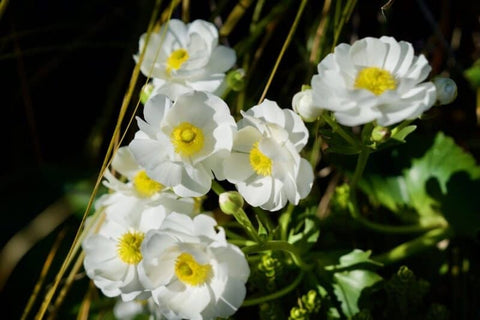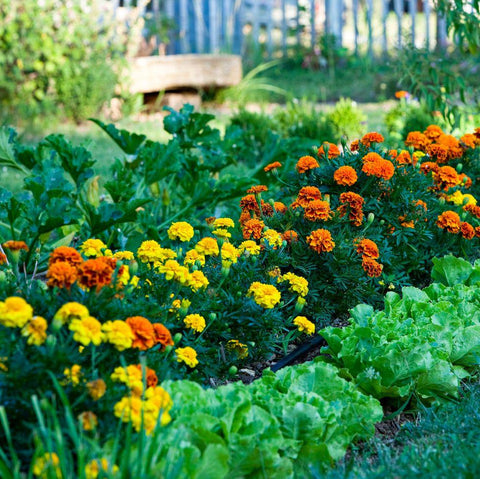You don't need to live in a tropical climate to grow plants in your backyard that provide a welcome touch of color to the gray and bare winter landscape. While there are naturally more options for winter flowering plants in warm and temperate climates, winter flowering plants are suitable for a variety of cold-resistant areas, even places with sub-zero temperatures in winter. The following content also has some reference value for raised garden beds.
Here are suggestions for winter-flowering shrubs, perennials, biennials, and ground cover.

01 Alaskan azaleas
This rhododendron variety is suitable for warm climates, with showy white flowers and yellow-green spots in late winter to early spring. It has dense leaves, and due to its compact size, it can also be grown as a container plant.
02 Aralia
For low-light environments, this evergreen shrub with large green leaves is a good choice for warmer climates. It has white flowers in late winter, followed by black ornamental berries. Since this is a tropical plant, it should have a shelter from the wind, even in a warm climate.
03 Perfume Princess Daphne
Of all the Daphne varieties, this hybrid blooms the earliest and lasts the longest. It also has good sunlight and heat resistance. In mid-winter to spring, a large number of highly fragrant flowers cluster together, beginning deep pink and fading to pink or white over time. This evergreen shrub is suitable for warm climates and grows upright.
04 Tassel flowers
Marginal flowers are evergreen shrubs suitable for mild climates. People choose them because their leaves change color all year round and their flowers are very fragrant. Loropetalum chinense 'Chang Nian Hong' is a compact variety with deep purplish-red leaves and deep red flowers. It blooms intermittently throughout the year, but is heaviest in late winter to spring.
05 Indian hawthorn
For plants that bloom in late winter, this evergreen shrub with large, tough leaves and fragrant pink flowers is a good choice in mild climates. Flowers are small, similar to crabapple flowers; Next is to enjoy the dark blue berries.
06 Japanese Dumplings
Japanese pine cone is a hardy broad-leaved evergreen shrub with smooth, leathery green leaves. Its white or pale pink flowers, which appear on the bush in late winter or early spring, resemble the flowers of the lily of the valley, but they are less intensely scented.
07 Honeysuckle horn
This evergreen broad-leaved plant is suitable for warm climates and can be grown as a shrub or vine. From fall to spring, it has clusters of brightly colored trumpet shaped flowers whose sweet nectar attracts hummingbirds. This plant, which is native to South Africa, is not a honeysuckle botanically, but a relative of the trumpet creeper.
08 Winter Jasmine
Winter jasmine does not need a tropical climate, and unlike most jasmines, it does not have fragrant flowers. The trade-off is that the shrub or vine (depending on how you plant it) will be covered in tiny yellow flowers before the plants leave again in late winter.
09 Witch hazel
Even in very cold climates in winter, the blooming of witch hazel is something to look forward to. Most plants need warmth to bloom, and witch hazel is the opposite. Bright, fragrant, spidery flowers only appear in cold temperatures. If you prefer native witch hazel, choose Virginia witch hazel or spring witch hazel. Among non-native witch hazel, hybrid witch hazel, which is a cross between Chinese and Japanese witch hazel, is the most popular.
10 horn aloe
From winter to spring, mature aloe plants grow tall stems with sharp, bright red-orange flowers that look like mature candelabra. This large aloe vera is native to the Cape region of South Africa as a warm climate plant. Its drought tolerance makes it suitable for horticultural landscapes.
11 Camellias
The long-lived camellia flower is one of the most popular winter flowering plants in warm climates. Without dark, glossy leaves and large, lush flowers, these evergreen shrubs come in so many colors that it can be hard to choose. They bloom in the weeks between autumn and early spring. Most camellias are cultivated varieties of camellia.

12 Christmas Roses
In warmer climates, hellebores can flower outdoors at Christmas time (in colder climates, you'll have to wait until spring when it breaks the frozen ground to see the flowers). With its thick evergreen leaves and rose-like flowers, it is an amazing winter flowering plant. Even if your climate is mild, make sure to plant in an area that gets plenty of winter sun and is protected from biting winter winds.
13 Algerian iris
This winter-flowering iris is unlike any other species of iris and grows in mild climates. The Algerian iris will add a stunning splash of color to your landscape with its deep purple, highly fragrant flowers that begin long before any other iris blooms in the spring. The Algerian iris is native to North Africa and the western Mediterranean. It is planted from the bulb in the spring and blooms in late fall to early spring.
14 Pansies
In areas with warm or mild winters, pansies can be grown as biennials. All pansies are hybrids, and breeding has produced hardier varieties so that you can extend their flowering into the winter. Pansy's heart-shaped petals are brightly colored or bicolor, often with face-like center markings, ideal for illuminating gray winter days.
15 Lantana
In frost-free climates, the lantern flower is a perennial that blooms all year round, making this vine an attractive and aromatic ground cover to add color to your winter landscape. The rich flower clusters come in a wide variety of colors, often almost fluorescent, creating a two-color effect. Since blue tana is considered an invasive plant in some places, check with your local municipality or local extension office to see if there are any restrictions on growing it.
16 Winter Aconite
This low-growing hardy perennial flowering plant outperforms even crocuses when it blooms in late winter, usually when there is still snow on the ground. The sunnier the place, the sooner you can see golden buttercup flowers. Winter aconite spreads easily and its bulb roots can form colonies, but you can control the plants by pulling them where you don't want them.
17 Cyclamen
Most people think of cyclamen as a houseplant, but in warmer climates it is a lovely ground cover that can grow in partially shaded areas, such as under trees. It dies during the plant's summer dormancy, regrows in the fall, and then blooms in the winter, producing small fragrant flowers on long stems.
18 year old snowdrop
These delicate bulbs live up to their name - they sprout even when there's still snow on the ground. Depending on your local climate, they bloom in February or March. They require little maintenance and naturalize. If you plant them on your lawn, make sure to prune them only in the spring when the leaves are completely dead.
19 snapdragons
Goldfish dragons usually flower in spring or summer, but in warm climates the long flowering season can extend into winter as the plant blooms in cool weather and stops flowering in hot summer. Not many winter flowers offer such a wide variety of colors to choose from.

20 Ornamental kale and cabbage
While ornamental cabbage and kale are not flowering plants by definition, they are just as beautiful as any winter flowering plant and can be grown even in climates with very cold winters. Nurseries sell them as annuals in the fall, but if you manage to get them through the winter, you'll get the added benefit of seeing the stems of this plant grow small yellow flowers the following spring.
Learn more
Flowering shrubs and perennials aren't the only plants that can spice up your winter. Other options for winter gardens are ornamental grasses, as well as conifers, evergreen shrubs, and deciduous trees with an attractive bark texture or color.
There are also many options for container plants of various sizes to add winter interest to your porch, patio or balcony.









